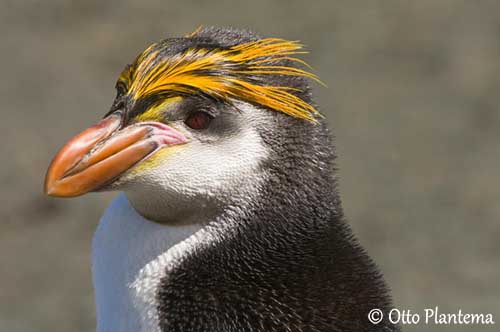

Royal Penguin
Otto Plantema
Trips around the world
SUB ANTARCTIC AUSTRALIAN ISLAND’S
ENDEMIC SPECIES
MACQUARIE ISLAND
Macquarie Island is located in SW Pacific Ocean, half way between New Zealand and Antarctic, and 1500 kilometres SE of Tasmania. The surface is about 128 square kilometres.
The island consists in two main pieces of plateau of 150/200 metres of elevation, joined by a narrow isthmus close to sea-level. There are two higher points, Mount Elder in NE, with 385 metres, and Mounts Hamilton and Fletcher in S, with 410 metres of elevation.
About the flora, the tussock-grass Poa foliosa grows up to two metres tall in sheltered areas, but usually, the plants rarely grow more than one metre in height. Some plant species, including two orchids, are endemic of the island.
There are only two endemic bird species, the Royal Penguin and the Macquarie Shag. But several other species are non-endemic residents.
Endemic bird species:
Royal Penguin - Eudyptes schlegeli - Gorfou de Schlegel
Macquarie Shag - Leucocarbo purpurascens - Cormoran de Macquarie
HEARD ISLAND AND McDONALD ISLANDS
These islands are a volcanic group of barren Antarctic Islands. They contain two active volcanoes, the only ones in the Australian territory. The Mawson Peak on Heard Island is 2, 745 metres of elevation.
These islands are in the Indian Ocean. There are among the most remote places in the world and are uninhabited.
Heard Island is the largest of the group with 368 square kilometres. This is a mountainous island, covered in glaciers and dominated by Mawson Peak.
The McDonald Islands are located 44 kilometres to W of Heard Island and consist of three small rocky islands of 2, 5 square kilometres (McDonald = 1, 13 square km).
These islands have low temperatures, persistent low cloud cover, frequent precipitation and strong winds. Snowfall occurs all year round.
The flora is limited to grasses and mosses, low-growing herbaceous flowering plants and Bryophytes (mosses). There are large areas of giant Antarctic Kelp (Durvillaea antarctica), and numerous species of seaweed.
There are only two endemic bird species, the Heard Shag and the Black-faced Sheathbill. However, numerous other birds are whether breeders or visitors, including penguins, petrels, albatrosses, skuas, terns and the Kelp Gull.
Endemic bird species:
Heard Shag - Leucocarbo nivalis - Cormoran de Heard
Black-faced Sheathbill - Chionis minor nasicornis - Petit Chionis
Other resident non-endemic species:
Black-browed Albatross - Thalassarche melanophris - Albatros à sourcils noirs
Brown Skua – Stercorarius antarcticus - Labbe antarctique
Gentoo Penguin - Pygoscelis papua - Manchot papou
Grey-headed Albatross – Thalassarche chrysostoma – Albatros à tête grise
King Penguin - Aptenodytes patagonicus - Manchot Royal
Light-mantled Albatross - Phoebetria palpebrata - Albatros fuligineux
Northern Giant-Petrel - Macronectes halli - Pétrel de Hall
Royal Penguin - Eudyptes schlegeli - Gorfou de Schlegel
Southern Giant Petrel – Macronectes giganteus – Pétrel géant
Southern Rockhopper Penguin - Eudyptes chrysocome - Gorfou sauteur
Wandering Albatross - Diomedea exulans - Albatros hurleur
White-headed Petrel – Pterodroma lessonii – Pétrel de Lesson
Photographer:
Otto Plantema
Trips around the world
Sources:
A Complete Guide to Antarctic Wildlife by Hadoram Shirihai and Illustrated by Brett Jarrett - Edited by Guy M. Kirwan - ALUL.A Press Oy, Finland - ISBN 9519894705
BirdLife International (BirdLife International)
Wikipedia, the free encyclopaedia
Sub Antarctic Islands – An Educational Resource of the Islands